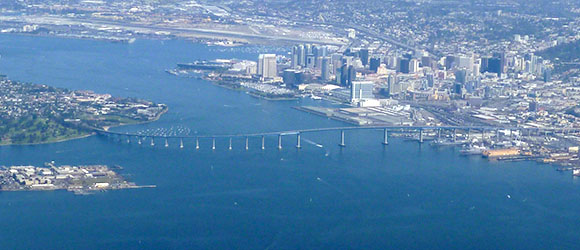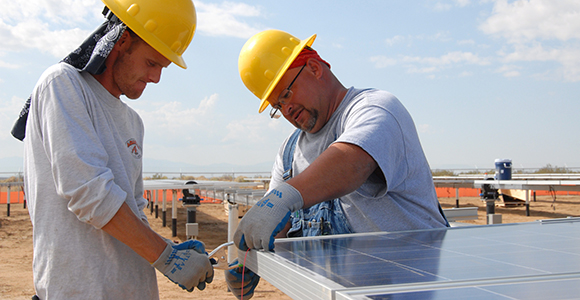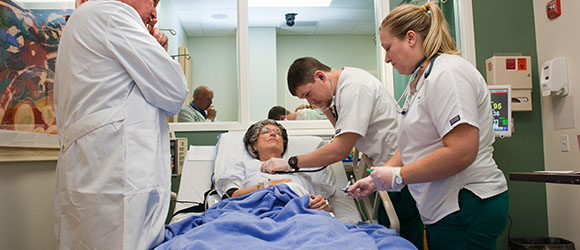The 2018 Roadmap to Shared Prosperity will include a call for the state to develop a coordinated approach to promoting the environmentally sustainable and socially equitable development of California's Blue Economy businesses and accelerating the development of pipelines for green jobs that are necessary to meet the state’s climate goals.
Additionally, the Summit is committed to promoting innovations in health care and supporting those pathways that target communities and regions with disproportionally high poverty.

(Photo Credit: Wingtipvortex/Wikimedia)
How middle-class jobs can emerge from California's Blue Economy on the coast and beyond
A recent commentary in the San Diego Union Tribune shines a light on the untapped potential of the Pacific Ocean and California’s future economy. San Diego alone is home to the largest maritime and water technology (BlueTech) cluster in the United States.
The Blue Economy has a diverse array of industries, including advanced manufacturing, information and communication technologies, innovation, military or defense, tourism, where BlueTech focuses on occupations that embrace technologically advanced tactics to solve water-related issues.
Given the rate of technological acceleration and the ambitious climate goals of California, Blue Economy and BlueTech offer significant opportunities to enhance economic prosperity and environmental health in the state.
Those available opportunities are vast – from aquaculture and fishing, to biomedicines, boat and shipbuilding, cables and connectors, desalination and water tech, floating infrastructure, marine recreation, marine robotics, maritime telecom, ocean energy, ocean observation, ports and marine transportation, professional services, and weather/climate change.
The potential impact of these industries does not solely reside along the 840 miles of coast along California. Advanced manufacturing jobs will play a pivotal role in the next phase of the Blue Economy and BlueTech. Much of this work can be done in inland areas of the state, like the Inland Empire Region.
San Diego is also showing the potential for the state's ports to become small business hubs by incubating Blue Economy startups, which can support well-paying, middle-class jobs.
In partnership with the San Diego Workforce Partnership and the Maritime Alliance, the 2017 California Economic Summit in San Diego (Registration and Information) will provide an opportunity on November 2 for partners to convene and solidify an official charter for work in 2018 to help young Californians understand the career pathways available in this important emerging sector and to help educational, workforce and economic development agencies explore the opportunities under the surface.

(Photo Credit: USAF)
Green Economy needs a workforce to match California’s climate change commitments
California has and will continue to experience an increased demand for skilled workers in the green or advanced energy economy as a result of the state’s climate change laws.
In a 2016 Next10 report, California ranks fourth in the world for the share of electricity generated from renewable sources and that percentage is increasing every year. This year, leaders extended the state’s commitment to its cap-and-trade program and also aim to address concerns about poor air quality in many communities throughout the state.
The recent cap-and-trade bill looks to the California Workforce Development Board to identify the resources and capacity needed to help industry, workers and communities adapt to economic changes that accompany the emissions reduction goals and determine if the existing pipelines are adequate to meet growing demand.
There is an opportunity here to better fill the pipeline by aligning investments in community colleges and other workforce development programs and training workers in the design, operation and manufacturing of green technologies, not just the installation and maintenance.
Increasing current pipelines and building new ones will make it easier to attract and grow jobs associated with the technology itself and provide more opportunity for Californians.
Equity is another concern when talking about rapid technological change. California must make an explicit commitment to create pathways into the green economy that begin in impoverished and environmentally at-risk communities. As well, lifting up low-income Californians into better paying jobs expands the state's capacity for innovation and entrepreneurship.
California Community Colleges have made efforts to make sure career technical education can match the state’s energy efficiency mandates and provide employers with quality workers. New standards for energy efficiency performance raise the bar for CTE programs—a challenge the colleges are ready to tackle through the availability of new funding opportunities, like the Strong Workforce Program.
Opportunities in the Blue and Green Economy both require industry alignment, partnership with the economic development community and shared commitment to develop a statewide initiative to build out these sectors in a sustainable, equitable and economically beneficial way.

(Photo Credit: CODNewsroom/Flickr)
California has an opportunity to accelerate health care innovations to close skills gap
The health care industry is experiencing a significant shortage of skilled talent and efforts to respond and improve health care career pathways have challenged colleges, universities and employers.
Improving these pathways represents a big step toward meeting California's need for one million more skilled workers. More importantly, hundreds of thousands of Californians could move into higher wage employment and careers with a future, given the industry's expansion. And in turn, all Californians would benefit from more accessible quality health care.
The California Community Colleges have introduced programs to train more health care workers to address regional shortages, such as a pilot program to help internationally trained nurses to more quickly become qualified for state certification.
In addition, several large heath care foundations are supporting California’s Future Health Workforce Commission to develop recommendations to address this issue. Many of the participants on this commission have contributed to the California Economic Summit and been partners in its One Million Workers Challenge.
The Commission is a significant opportunity to draw attention to this issue and for the Summit network in the coming year to catalyze innovations in health care education. Regional solutions could be presented to the Commission to help inform a plan to overcome barriers to implementation and tactics for dealing specifically with legal, financial and cultural barriers often experienced in this field.
Promising heath care pathway models are already in use throughout California’s diverse regions. The California Economic Summit network and partners could use 2018 to promote those models and increase awareness among business, civic, labor and nonprofit leaders on the potential for better health care pathways to reduce poverty and improve local health care.
Interested in joining this conversation? Have data to share? Want to share your solution?
Contact leah@cafwd.org and register here to be there at the 2017 California Economic Summit on November 2 and 3.
Subscribe to the Workforce Essentials newsletter from the California Economic Summit and receive valuable, shareable workforce news and tools like these. SUBSCRIBE TODAY.

